Vesper multinervatus, synonym Cymopterus multinervatus, is a species of flowering plant in the carrot family Apiaceae, known by the common name purplenerve springparsley. It is a perennial herb native to the southwestern United States, including the desert regions. It is stemless, producing leaves and inflorescence at ground level from a taproot. The leaves are erect on petioles of a few centimeters in length, with a fleshy blade dissected into waxy multilobed leaflets. The inflorescence arises on a stout purple or greenish peduncle up to about 14 centimeters tall. At the top is a rounded cluster of purple flowers sheathed in purple-veined bracts.
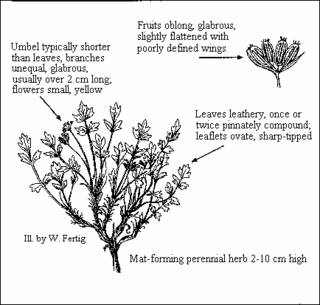
Aletes has been regarded a genus of flowering plants in the family Apiaceae, all of which are endemic to North America. As of December 2022, Plants of the World Online regarded Aletes as a synonym of Cymopterus, while GRIN Taxonomy regarded it as a possible synonym of that genus.
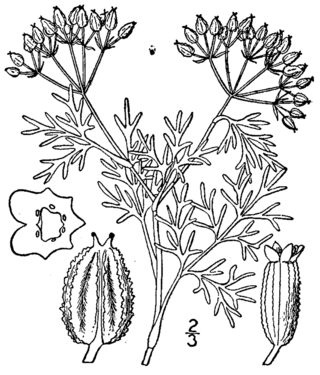
Ammoselinum is a genus of flowering plant in the family Apiaceae, known commonly as sandparsley. It is native to temperate North and South America.
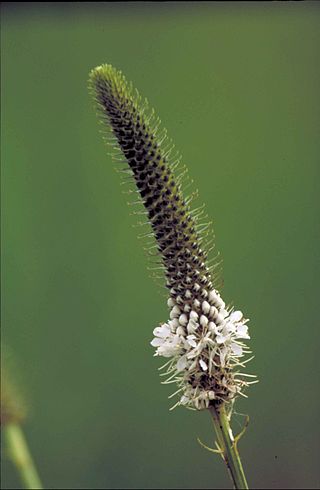
Dalea is a genus of flowering plants in the legume family, Fabaceae. Members of the genus are commonly known as prairie clover or indigo bush. Its name honors English apothecary Samuel Dale (1659–1739). They are native to the Western hemisphere, where they are distributed from Canada to Argentina. Nearly half of the known species are endemic to Mexico. Two species of Dalea have been considered for rangeland restoration.
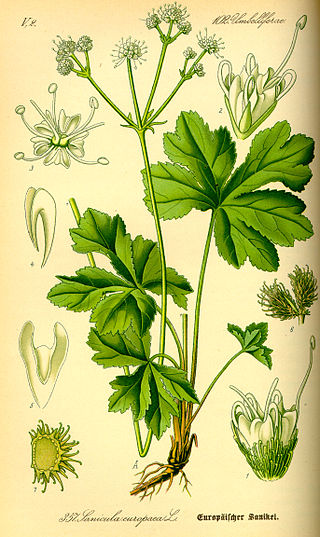
Sanicula is a genus of plants in family Apiaceae, the same family to which the carrot and parsnip belong. This genus has about 45 species worldwide, with at least 22 in North America. The common names usually include the terms sanicle or black snakeroot.

Cymopterus is a genus of perennial plants in the family Apiaceae native to western North America. They are commonly known as the spring parsleys. They are mostly stemless, taprooted perennial herbs with leaves at ground level and flowering scapes bearing yellow, white, or purple flowers.
Niphogeton is a genus of flowering plant in the family Apiaceae.

Perityle is a genus of flowering plants in the daisy family. They are known generally as rock daisies.

Lomatium cuspidatum is a perennial herb of the family Apiaceae, native to the U.S. state of Washington. It is found primarily on open rocky slopes in the Wenatchee Mountains, strongly associated with serpentine scree and soils.

Lomatium donnellii is a perennial herb of the family Apiaceae, in the Western United States.

Lomatium grayi, commonly known as Gray's biscuitroot, Gray's desert parsley, or pungent desert parsley, is a perennial herb of the family Apiaceae. It is native to Western Canada in British Columbia, and the Western United States, including from the Eastern Cascades and northeastern California to the Rocky Mountains.
Prionosciadium is a genus in the carrot family, Apiaceae. It is endemic to Mexico. The plants are biennial herbs with large taproots.

Lomatium plummerae is a formerly recognized species of plant in the carrot family (Apiaceae). When recognized, it was subdivided into a number of subspecies and varieties. As of August 2021, Plants of the World Online considers the species itself and the variety helleri to be synonyms of Lomatium donnellii, and the varieties austiniae and sonnei as synonyms of Lomatium austiniae, whereas the Jepson eFlora considers the species and the varieties austiniae and sonnei to be synonyms of Lomatium donnellii.
Spermolepis is a genus of flowering plants belonging to the family Apiaceae.
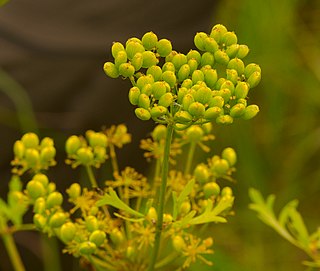
Polytaenia is a genus of flowering plants belonging to the family Apiaceae.
Donnellsmithia is a genus of flowering plants belonging to the family Apiaceae.
Rhodosciadium is a genus of flowering plants belonging to the family Apiaceae.
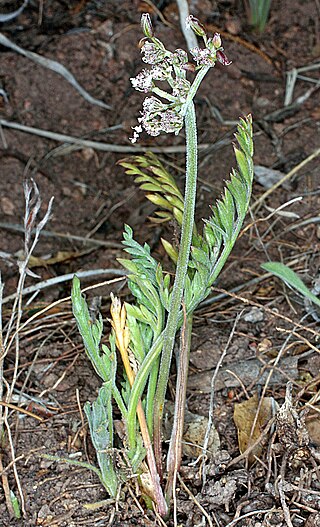
Lomatium orientale, commonly known as salt-and-pepper, eastern cous, eastern desert-parsley, eastern lomatium, white-flowered desert-parsley, oriental desert parsley or Northern Idaho biscuitroot, is a small spring blooming ephemeral plant. It grows in open habitats from the plains to foothills in western North America. It is known as one of the earliest blooming native flowers in its habitat. The species name, "orientale", is botanical Latin meaning "eastern".












